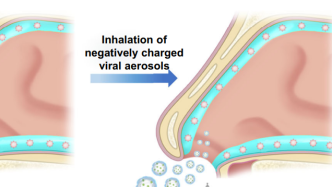

Just spray it and put a mask on your nose! A research team from the Institute of Process Engineering of the Chinese Academy of Sciences proposed a new strategy for "intranasal masks" and innovated the dosage form. Relevant papers were published online in the international academic journal Nature Communications.
On December 27, the Institute of Process Engineering of the Chinese Academy of Sciences announced that it had recently proposed a new strategy for "intranasal masks" and innovative dosage forms. It was verified by mouse and human nasal cavity digital models and human respiratory tract simulation models and found that It can form a protective layer on the nasal cavity wall to intercept virus aerosols and inactivate the virus .
Aerosols are the main mode of transmission of viral respiratory infectious diseases.
The use of masks has been one of the important methods in public health work to reduce the infection rate of respiratory infectious diseases, especially during the COVID-19 pandemic. However, previous studies have shown that masks are only 67% protective against the new coronavirus (SARS-CoV-2); and the protective effect against mutated strains of the virus, such as Omicron, is even worse. So, what new strategies can be used to improve the protective effect against viral aerosols?
Since virus aerosols can invade the human body through the nasal cavity, researchers envision setting up a "gateway" or "shield" in the nasal cavity - applying a "coating" that can effectively intercept or even inactivate the virus.
Based on years of research on biological dosage form engineering, the team of Ma Guanghui, an academician of the Chinese Academy of Sciences and a researcher at the State Key Laboratory of Biochemical Engineering at the Institute of Process Engineering, and researcher Wei Wei created an "intranasal mask". Just spray it and put a mask on your nose!
The new "mask" is composed of a thermosensitive hydrogel (GEL) carrying a positive charge and micron-sized cellular vesicles (MV) with high expression of viral receptors on the surface to form a protective layer (MV@GEL).
When viral aerosols are inhaled into the nasal cavity, the positively charged GEL in the protective layer can intercept and adsorb the negatively charged viral aerosol particles, blocking their spread to the downstream trachea and lungs. The MVs chimeric in the gel can further rely on the highly expressed receptors on the surface to trap the virus into the interior of the vesicles and inactivate them, thus protecting the nasal epithelial cells from being infected by the virus. The synergistic effect of the above-mentioned "interception" and "inactivation" reduces the risk of viral infection.
Through experiments on virus infection models and virus transmission models in mice, researchers found that "intranasal masks" can effectively protect the nasal cavity and lungs of mice from virus aerosol infection.
The aforementioned research team conducted cross-collaboration with the team of Wang Limin, a researcher at the National Key Laboratory of Science and Engineering in the Institute of Process Engineering, and used Computational Fluid Dynamics-Discrete Particle Simulation (CFD-DPS) technology to calculate the distribution state of aerosol particles in the nasal cavity under breathing behavior. It is proved that the interception rate of MV@GEL for aerosol particles reaches 93.2%.
In addition, the research team used 3D printing technology to obtain a physical model of the human nasal cavity, and connected it with the human lung organoid module (simulating lung tissue) and the airflow duct module (simulating respiratory airflow) to build an integrated human respiratory tract simulation model. On this basis, it was proven that the "intranasal mask" can effectively reduce the infection rate of lung organoids by different virus aerosols.
However, the above research results belong to the preclinical research stage, and the actual clinical efficacy needs to be further verified. On December 18, the aforementioned research results were published online in the international academic journal Nature Communications.
The researchers said that in view of the versatility , flexibility and safety of the system , it is expected that in the future, specific protective "intranasal masks" for different viruses can be quickly constructed by replacing the virus receptors on micron-sized cell vesicles, and can By combining it with traditional masks , a more efficient protective effect can be achieved.
This research work was supported by the National Natural Science Foundation of China, the Beijing Natural Science Foundation, the National Key R&D Program, the Strategic Priority Science and Technology Project of the Chinese Academy of Sciences, the Frontier Basic Research Project of the Institute of Process Engineering, and the Beijing Science and Technology Star Program.
Paper link: https://www.nature.com/articles/s41467-023-44134-w